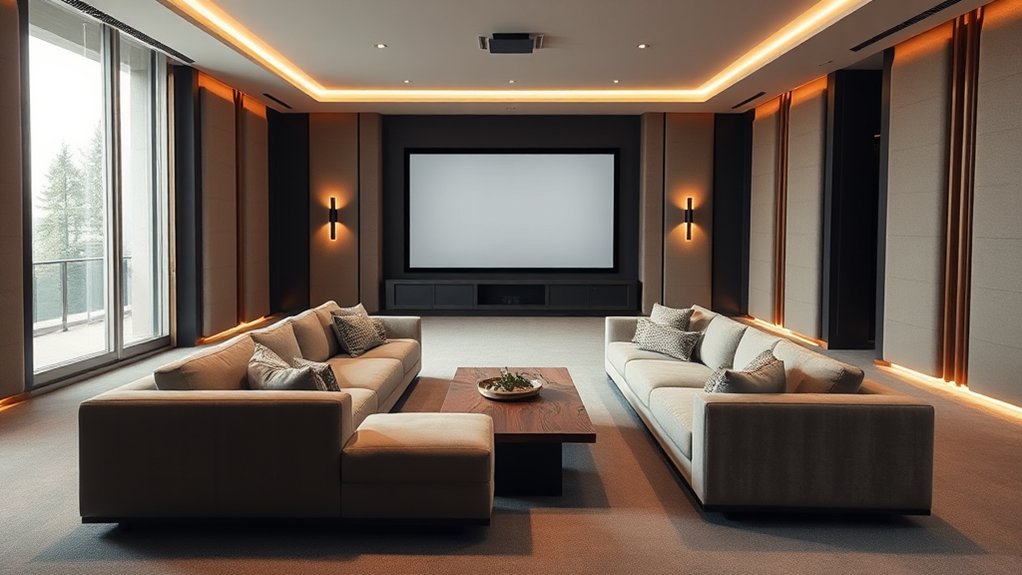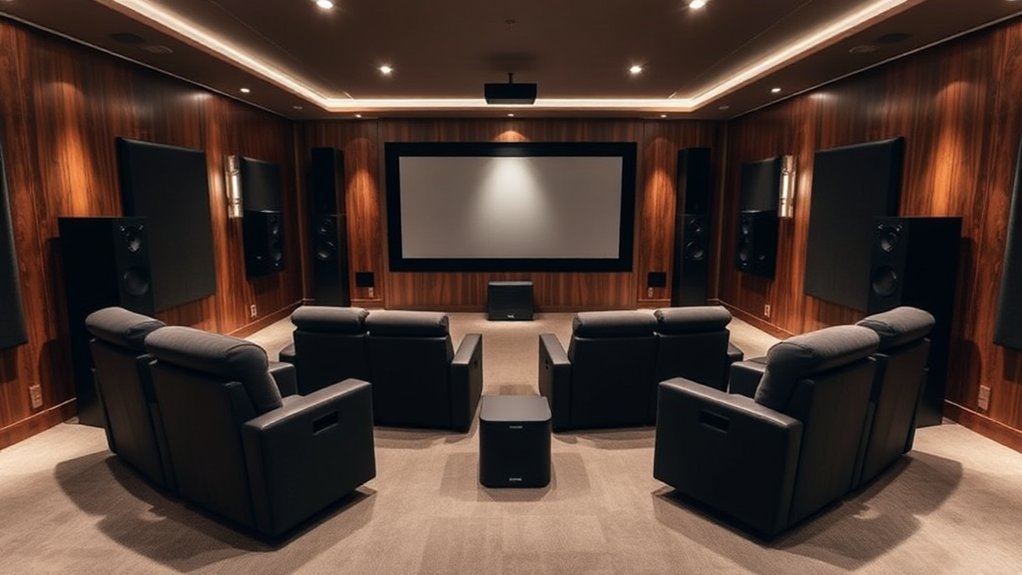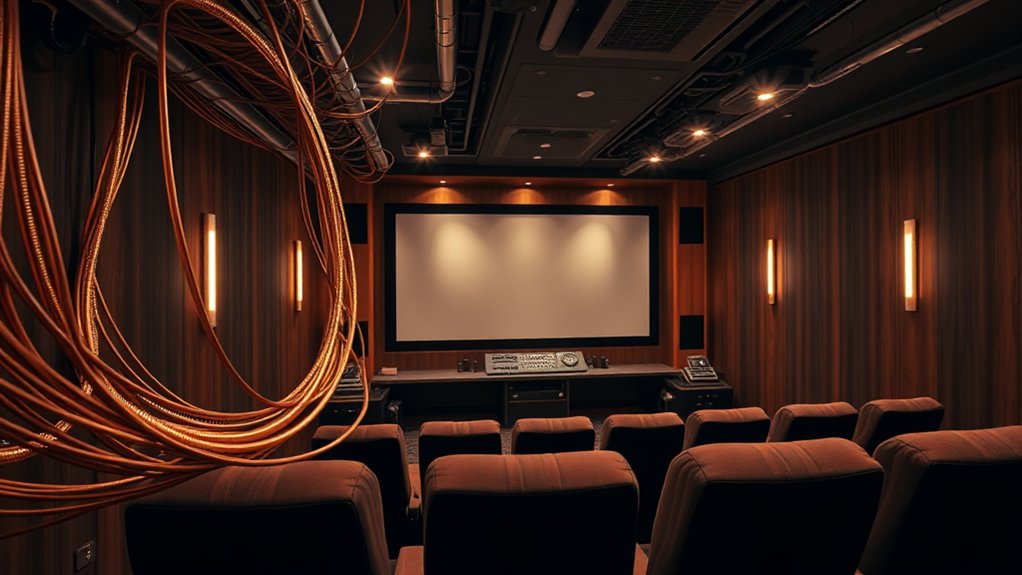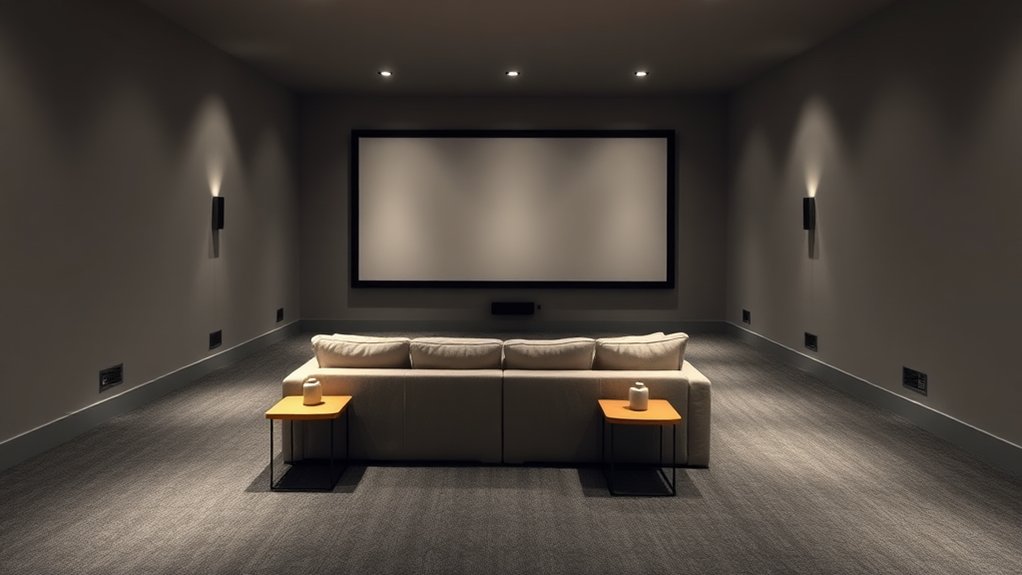When designing an open concept theater room, start by choosing a rectangular shape for better sound balance. Guarantee effective layout and seating arrangements, allowing for unobstructed views and easy movement. Improve acoustics with absorption panels and bass traps to minimize echoes. Smart lighting is vital; it should adjust automatically to create the right mood for movie nights. Select comfortable, functional furniture that matches your style, and think about tech integration for seamless control. Curious about maximizing that multimedia experience?
Key Highlights
- Choose a larger rectangular shape for the room to optimize sound balance and reduce problematic room modes.
- Incorporate acoustic treatment like panels and bass traps to enhance clarity and control echoes in the open space.
- Select comfortable modular seating that allows for easy reconfiguration and includes features like recliners and built-in storage.
- Implement smart lighting solutions that can be adjusted for brightness and color, enhancing ambiance for various activities.
- Ensure proper technology integration with smart devices for seamless control over lighting and sound during movie nights and gatherings.
Choosing the Right Room Shape for Sound Optimization
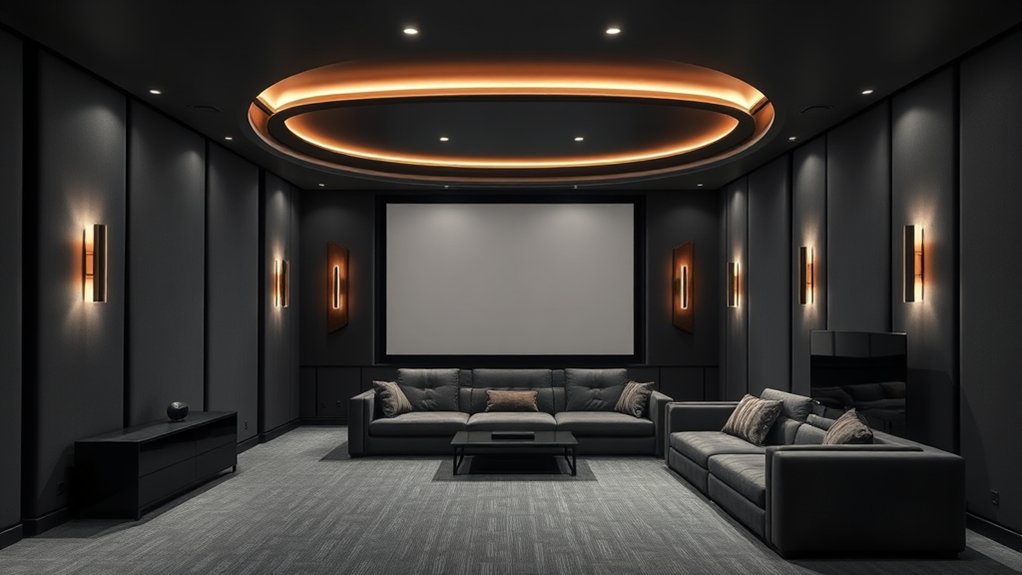
Regarding the design of an open concept theater room, choosing the right room shape can greatly impact your sound experience, especially if you’re trying to avoid the dreaded “boominess” that often plagues smaller, square spaces.
Larger rectangular rooms are your friends here; they produce more balanced sound and fewer problematic room modes. Why? Since square spaces tend to create uneven bass response and annoying standing waves. Additionally, understanding room shapes is vital for optimizing the audio experience. Acoustic design is often overlooked, yet it plays a critical role in enhancing the overall audio quality in such environments.
If you opt for non-parallel walls, you can reduce reflections that lead to those unpleasant sonic distortions; just be ready for some unpredictability in sound behavior. Avoid concave surfaces, as they focus sound reflections and can lead to unexpected echo or flutter effects.
Effective Room Layout and Seating Arrangements
Designing an effective room layout for your open concept theater isn’t just about plopping down some seats and hoping for the best; it’s like crafting a fine recipe where every ingredient needs to complement the others.
Start by determining your seating capacity, ensuring ample room for movement, and allow for recline space. Stagger and tier your seats to maintain unobstructed views—nobody wants to peer over a giant head, right? Creating a perfect sound, design, and visuals mirrors the experience of a real movie theater. Place your screen at an ideal distance, ideally 1.5 to 3 times the screen height, so you can enjoy every detail comfortably. Remember, spacious aisles of at least 20 inches make egress easy, and ergonomic seat designs improve comfort, making your theater a welcoming space for everyone, including those with mobility needs. Additionally, careful design of the home theater layout ensures efficient space usage that enhances the overall viewing experience.
Enhancing Acoustics With Proper Treatment
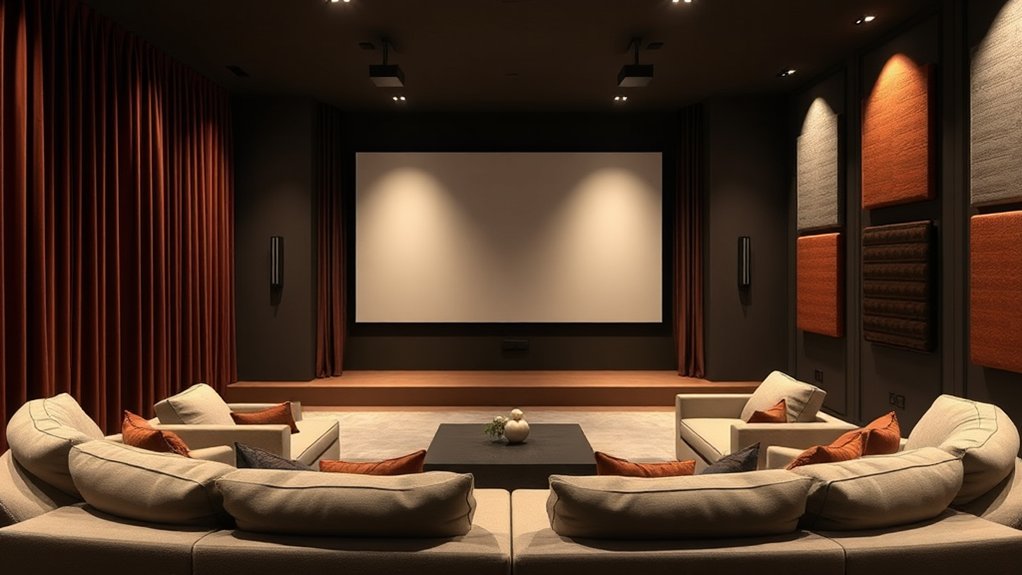
Creating the perfect open concept theater goes beyond just choosing the right seating and screen placement; it’s about crafting an audio experience that immerses you in every scene.
To improve acoustics, you’ll want to utilize both absorption and diffusion techniques. Acoustic panels, made from materials like foam or fiberglass, can greatly reduce those annoying echoes, as well as diffusers scatter sound waves to create a smoother audio environment. Sound absorption techniques are key to reducing reverberations that can muddy your audio clarity.
Enhancing your theater’s acoustics requires a balance of absorption and diffusion for optimal sound clarity.
Think of it as baking: too much sugar (absorption) can leave things flat, whereas a pinch of spice (diffusion) keeps it lively. Don’t forget to address low frequencies with bass traps in corners, controlling booming sounds that can distract from your favorite moments.
With strategic placement and a mix of treatments, you’ll guarantee every note hits just right.
Implementing Smart Lighting Solutions
Though you might think that lighting in an open concept theater room is merely about illumination, it plays a pivotal role in shaping your viewing experience.
By using smart lighting solutions, like adjustable A19 bulbs and lively light strips, you can customize brightness and color to set the perfect mood for any film genre. Imagine watching a thrilling action movie with dynamic color changes enhancing the adrenaline rush, or dimming the lights for a cozy romantic scene.
Plus, scheduling features can automate shifts, gently fading the lights as the show starts; after all, who doesn’t love a little drama?
Integrating these smart solutions not only boosts ambiance but furthermore adds a layer of convenience to your cinematic enjoyment.
Selecting Comfortable and Functional Furniture
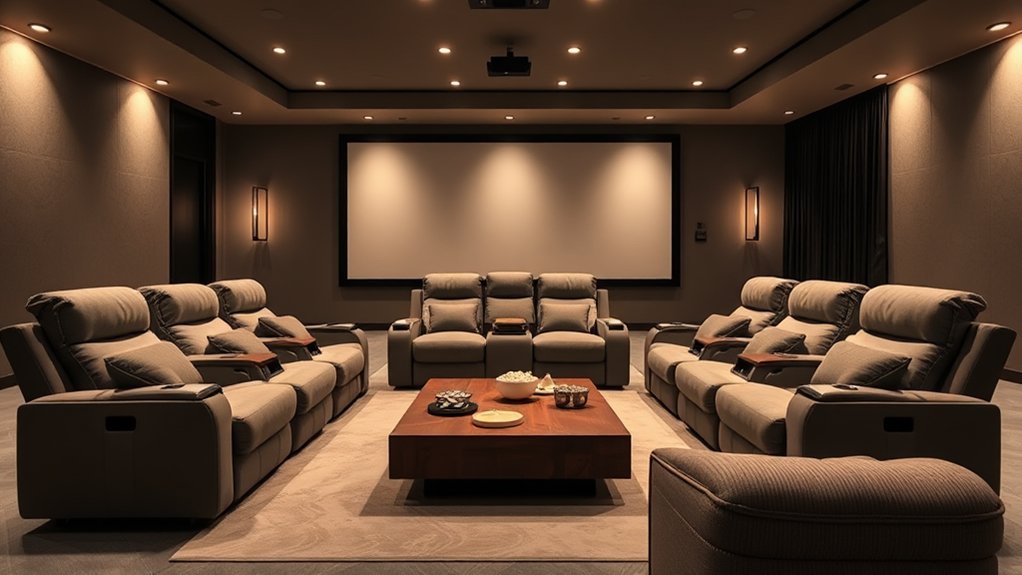
The heartbeat of any open concept theater room lies in its furniture, where comfort meets functionality in perfect harmony.
Choose modular seating, as it allows you to reconfigure your arrangement easily for different events and group sizes—because who wants to be stuck with a rigid setup?
Reclining chairs enhance your comfort game, letting you find that perfect lounging position.
Reclining chairs are the ultimate upgrade, allowing you to settle into the perfect lounging position for movie marathons.
Staggered rows and raised back seats guarantee unobstructed views, as low-back sofas maintain open sight lines, which is a win-win.
And don’t forget durable upholstery; options like leather are easy to clean, ideal for rowdy movie marathons.
Want to level up? Scour for built-in cup holders or storage to keep snacks and remotes handy.
Consider adding a soundbar that supports advanced audio technologies to elevate your movie experience even further.
Who doesn’t love convenience?
Setting Up the Visual and Screen Components
When you’re diving into the setup of your open concept theater room, getting the visual and screen components just right is crucial for creating an unforgettable experience.
Start by confirming your ceiling height is between 9 to 10 feet, which is ideal for acoustics.
Next, consider dimensions—rooms following ratios like Sepmeyer (1:1.28:1.54) can improve your audio and visuals.
For screen placement, aim for the center to align with viewers’ eye levels, avoiding that awkward neck strain we all dread.
Projector screens, sized correctly according to viewing distance, can provide an immersive feel, whereas using high-resolution options guarantees crisp images.
Don’t forget about ambient light—choosing the right screen material can make all the difference, right?
Strategies for Room Separation and Privacy
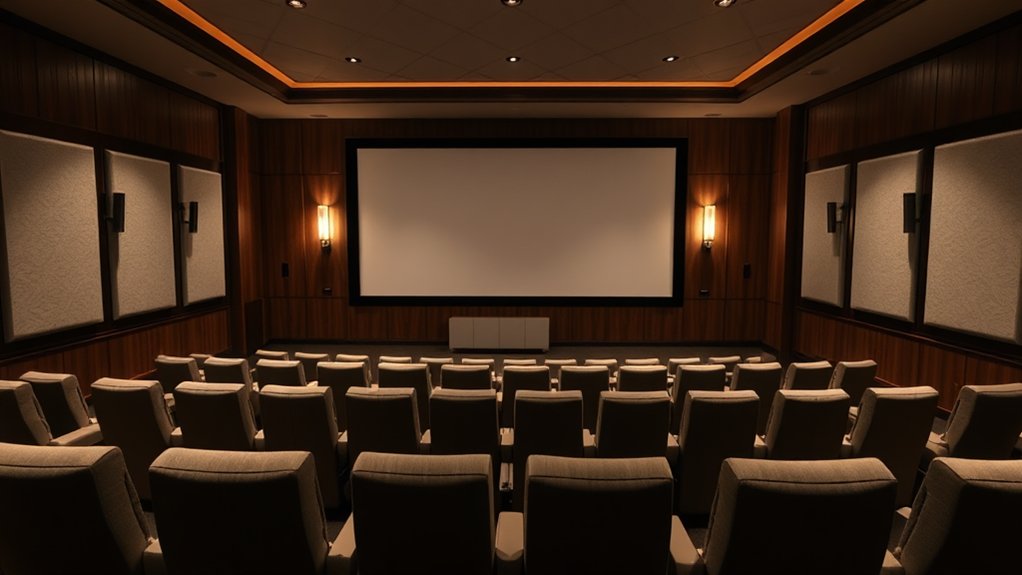
Creating an open-concept theater room doesn’t mean you have to sacrifice privacy, especially if you desire a cozy environment for movie nights. Consider using sliding doors or room dividers; these options effectively separate your theater area from the rest of the space, allowing you to enjoy your movies without disruptions.
When you need that privacy, simply close them to block noise and maintain focus on the film. Furniture placement is essential too—grouping sofas and chairs can create defined zones as they act as informal barriers.
To enhance your experience, why not utilize curtains or flexible partitions? They can easily enclose the theater during a film and open up for social gatherings, keeping both functionality and style in mind.
Multi-Use Space Planning for Functionality
Designing a multi-use space in your open-concept theater room can transform the way you enjoy entertainment, social gatherings, and even work-related activities.
By using modular seating, you can easily rearrange configurations for movie nights or casual hangouts. Imagine sectional sofas creating a comfy environment as ottomans double as storage—practical, right?
To define spaces within your open layout, area rugs and strategic furniture placement can work wonders without the need for physical barriers.
Plus, lighting control with dimmable options guarantees you set the perfect mood for any occasion.
Don’t forget acoustics; optimizing sound can make movie-watching seamless while maintaining a tranquil atmosphere during meetings.
Fundamentally, thoughtful planning maximizes functionality and improves enjoyment!
Considerations for Technology Integration and Control
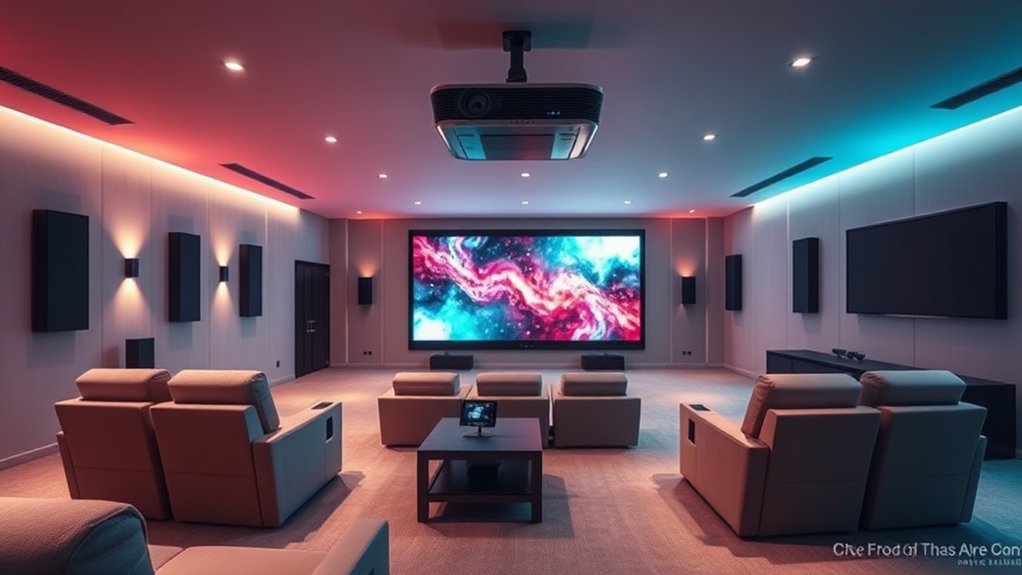
To truly uplift your open-concept theater room, it’s essential to weave together various technological elements that improve functionality and enjoyment. Start by ensuring all your smart devices support common communication protocols like Wi-Fi or Zigbee, making connectivity a breeze.
You wouldn’t want to juggle complicated remotes, right? Developing preset scenarios can automatically adjust lighting and sound for movie nights or gaming sessions, enhancing your experience. Furthermore, integrating smart lighting that responds to ambient light levels means you’ll always have ideal viewing conditions. And don’t forget about energy efficiency—who doesn’t want to lower those utility bills? Additionally, incorporating a stylish soundbar can create an immersive audiovisual experience that complements your open-concept design.
Frequently Asked Questions
What Is the Ideal Ceiling Height for a Theater Room?
For an ideal theater room, you should aim for a ceiling height of 9 to 10 feet. This height improves acoustic performance and spatial comfort, ensuring an immersive viewing experience without sacrificing sound quality.
How Do I Minimize Sound Leakage to Other Rooms?
To minimize sound leakage, you’ll want to use soundproof materials, seal gaps with acoustic caulking, and install heavy doors. Incorporating acoustic panels and insulation will help absorb sound, keeping your space quieter.
Can I Install a Projector on a Ceiling Mount?
Yes, you can install a projector on a ceiling mount. Just make certain that the mount matches your projector’s weight and screw pattern, and follow proper installation guidelines for secure positioning and best viewing experience.
What Colors Work Best for Theater Room Walls?
For theater room walls, choose dark colors like black, dark gray, or navy. These absorb light, improve contrast, and minimize distractions. Opt for matte finishes to avoid glare and create an immersive viewing experience.
How Can I Incorporate Technology Easily Into My Design?
To easily incorporate technology, choose smart systems that merge effortlessly with your design. Use voice commands for control, automate lighting and sound settings, and prioritize user-friendly interfaces to improve your experience without hassle.

